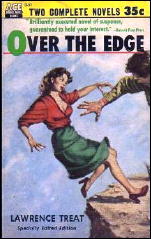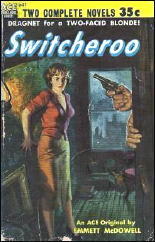Thu 22 Mar 2012

LAWRENCE TREAT – Over the Edge. Ace Double D-51, reprint paperback, abridged edition, 1954. Published dos-Ã -dos with Switcheroo, by Emmett McDowell. Originally published by William Morrow & Co., hardcover, 1948.
Over the Edge plumbs some of the same pipes as The Big Clock, to good effect. Alec Rambeau, the central character, is empaneled on a jury in a murder trial and finds that the murdered woman in the case was recently his lover — he didn’t recognize her married name.
Nagged by guilt (he’s married) Alec pushes for conviction of her suspect/husband in a nicely-turned scene that reads like a reverse 12 Angry Men, skillfully turning the other jurors to his side and sending the accused to the Death House … only to discover later that the man is innocent.

What follows is a tricky, twisting detection-dance, as Alec tries to investigate the murder and the dead woman’s relationships without revealing his own involvement. Neat enough, but the author puts yet another spin on things as we begin to question just how innocent Alec really is.
Writing in the third person, Treat reveals/withholds just enough to keep us guessing right up to the last suspenseful chapter, which is skillful writing indeed, and the kind of thing I’ll look for more of.
Oh. The flip side of this Ace Double is Switcheroo, by Emmett McDowell; a mystery-comedy that could be charitably described as Belabored.
March 23rd, 2012 at 4:46 pm
Lawrence Treat was an early writer of police procedurals, with such novels as V as in Victim (1945), H as in Hunted (1946), Q as in Quicksand (1947). His series characters included Mitch Taylor, Bill Decker (both cops) and Jub Freeman, a forensics expert, sometimes all three, other times in pairs or on occasion, solo appearances.
He obviously was a forerunner of Sue Grafton as far as titles are concerned, although Treat’s did not come in alphabetical order.
He was also the winner of two Edgars, one for a short story in 1965, according to Wikipedia, the other a Special Edgar Award in 1978 for editing a new edition of the Mystery Writer’s Handbook.
Not being a procedural fan myself, I had to rely on outside sources for most of this information. It’s also partially the reason why I’ve never read OVER THE EDGE, thinking it something other than Dan’s description of it. My loss, apparently!
March 23rd, 2012 at 5:44 pm
The short story which earned Treat his first Edgar was “H is for Homicide” – Sue Grafton later (coincidentally?) used the same title for one of her Kinsey Milhone mysteries.
I own the French edition of the Mystery Writer’s Handbook which is a great read whether or not you intend to make a living out of fictional crime. Stanley Ellin’s chapter on revision alone is worth the price of the book.
March 23rd, 2012 at 7:15 pm
Dan Stumpf’s review of this novel reminds me why I need to visit this site more often. Treat was a lawyer, but I stated in NOVEL VERDICTS that TRIAL AND TERROR (1949) was his only courtroom novel. I was fairly negative on that book, but this one sounds much more interesting.
March 25th, 2012 at 11:36 am
If she goes up mountains in shoes like the ones on the cover it served her right.